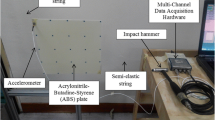Abstract
The resonant-based identification of the in-plane elastic properties of orthotropic materials implies the estimation of four principal elastic parameters: E 1 , E 2 , G 12 , and ν 12 . The two elastic moduli and the shear modulus can easily be derived from the resonant frequencies of the flexural and torsional vibration modes, respectively. The identification of the Poisson’s ratio, however, is much more challenging, since most frequencies are not sufficiently sensitive to it. The present work addresses this problem by determining the test specimen specifications that create the optimal conditions for the identification of the Poisson’s ratio. Two methods are suggested for the determination of the Poisson’s ratio of orthotropic materials: the first employs the resonant frequencies of a plate-shaped specimen, while the second uses the resonant frequencies of a set of beam-shaped specimens. Both methods are experimentally validated using a stainless steel sheet.








Similar content being viewed by others
References
Lecompte D, Lauwagie T, Sol H, Heylen W, Vantomme J (2005) A comparison between static and dynamic inverse modelling for the identification of orthotropic elastic material parameters. Proceedings of the 2nd International Conference on Computational Methods and Experiments in Material Characterisation, November, Portland, Maine, USA
Roebben G, Duan R-G, Sciti D, Van der Biest O (2002) Assessment of the high temperature elastic and damping properties of silicon nitrides and carbides with the impulse excitation technique. J Eur Ceram Soc 22:2501–2509. doi:10.1016/S0955-2219(02)00111-5
Förster F (1937) Ein neues Messverfahren zur Bestimmung des Elastizitätsmoduls und der Dämpfung. Z Met.kd 29:109–115
Pickett G (1945) Equations for computing elastic constants from flexural and torsional resonant frequencies of vibrating prisms and cylinders. Proceedings ASTM 45:846–865
Spinner S, Teft WE (1961) A method for determining mechanical resonance frequencies and for calculating elastic moduli from these frequencies. Proceedings ASTM 61:1209–1221
ASTM Standard C 1259-01 (2001) Standard test method for dynamic young’s modulus, shear modulus, and poisson’s ratio for advanced ceramics by impulse excitation of vibration
Sol H (1986) Identification of anisotropic plate rigidities using free vibration data, Ph.D. thesis. Vrije Universiteit Brussel, Brussels, Belgium
Sol H, Oomens CWJ (1997) Material identification using mixed numerical experimental methods. Kluwer Academic, Kerkrade, The Netherlands
Lauwagie T, Lambrinou K, Patsias S, Heylen W, Vleugels J (2007) Resonant-based identification of the elastic properties of layered materials: application to air-plasma sprayed thermal barrier coatings. NDT&E Int 41:88–97
De Visscher J (1995) Identification of the complex stiffness matrix of orthotropic materials by a mixed numerical experimental method, Ph.D. thesis. Vrije Universiteit Brussel, Brussels, Belgium
Blevins RD (1979) Formulas for natural frequency and mode shape. Litton Educational, New York, USA
Beck JV, Arnold KJ (1977) Parameter estimation in engineering and science. Wiley & Sons, New York, USA
Imamovic N (1998) Validation of large structural dynamics models using modal test data, Ph.D. thesis. Imperial College of Science, Technology & Medicine, London, UK
Lauwagie T, Sol H, Heylen W (2006) Handling uncertainties in mixed numerical-experimental techniques for vibration based material identification. J Sound Vib 291:723–739. doi:10.1016/j.jsv.2005.06.025
Jones RM (1975) Mechanics of composite materials. McGraw-Hill, New York, USA
Lauwagie T (2005) Vibration-based methods for the identification of the elastic properties of layered materials, Ph.D. thesis. Katholieke Universiteit Leuven, Leuven, Belgium
Acknowledgments
This work was performed in the framework of the GRAMATIC research project supported by the Flemish Institute for the Promotion of the Scientific and Technological Research in Industry (IWT).
Author information
Authors and Affiliations
Corresponding author
Rights and permissions
About this article
Cite this article
Lauwagie, T., Lambrinou, K., Sol, H. et al. Resonant-Based Identification of the Poisson’s Ratio of Orthotropic Materials. Exp Mech 50, 437–447 (2010). https://doi.org/10.1007/s11340-009-9250-9
Received:
Accepted:
Published:
Issue Date:
DOI: https://doi.org/10.1007/s11340-009-9250-9




